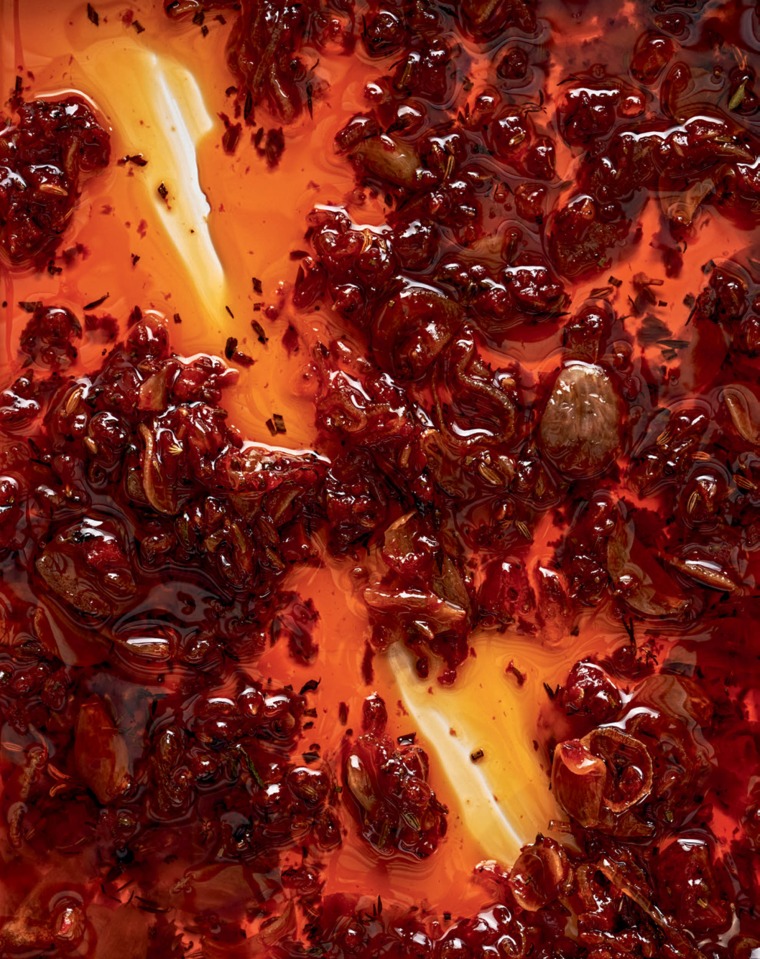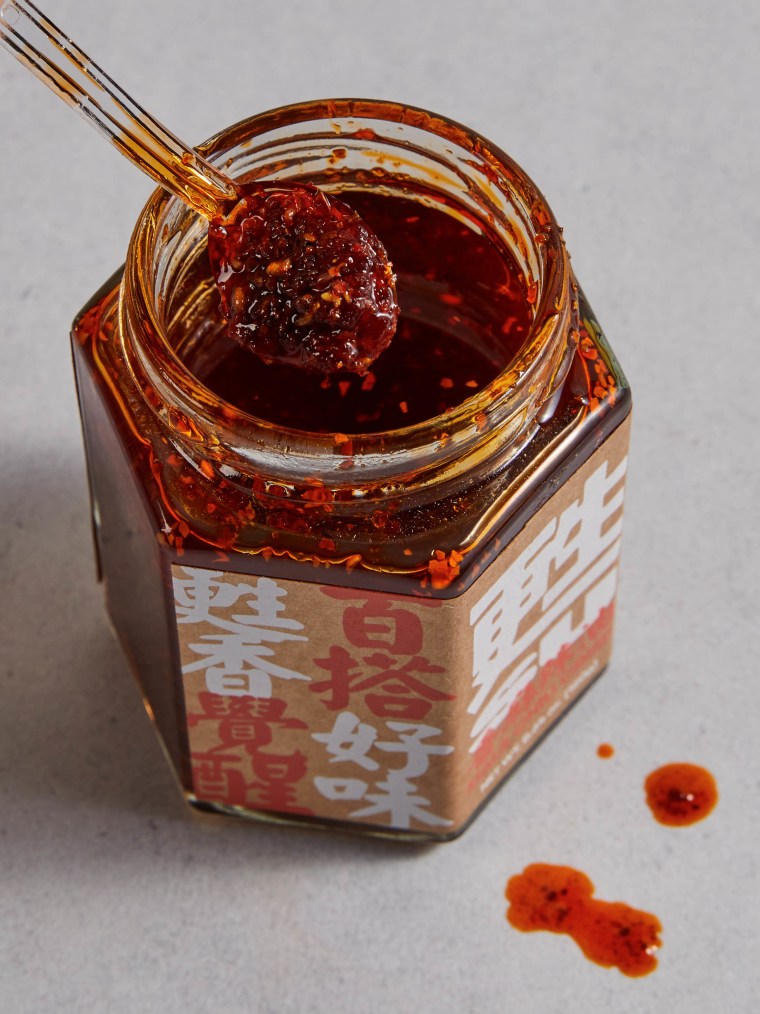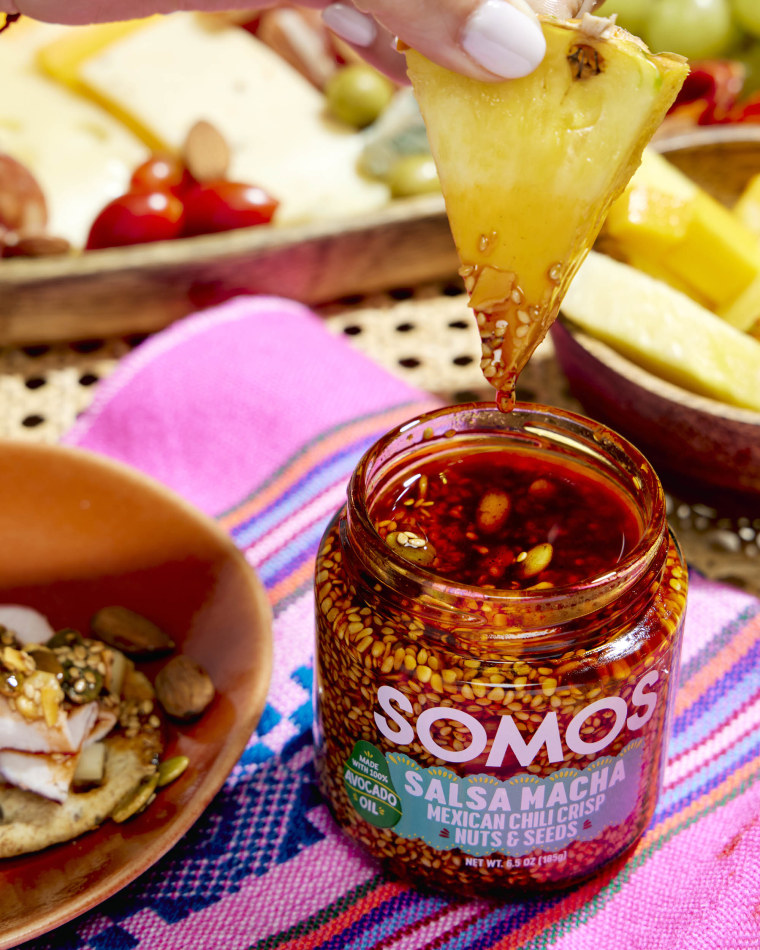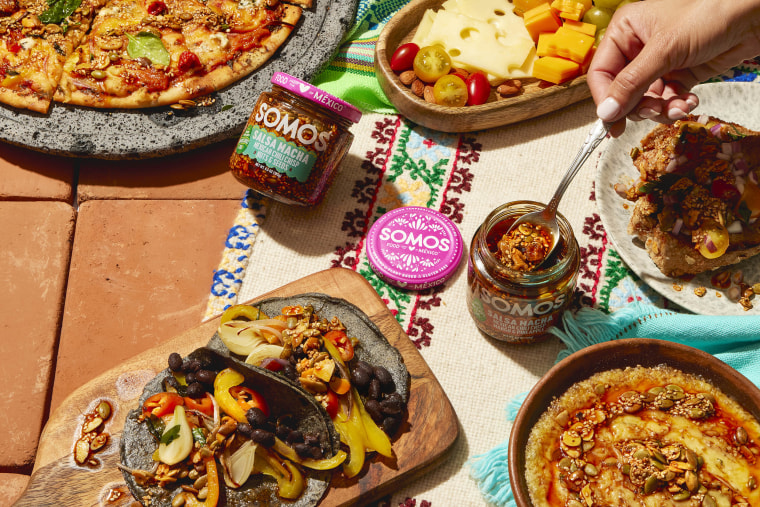You might reach for it at Chinese restaurants or consider it a household staple, right next to the mustard in your refrigerator: Asian chili crisps have exploded onto the mainstream market in the U.S. in recent years. But now, the versatile condiment is paving the way for other global sauces — also made from oil-fried peppers fragranced with spices, nuts or seeds — to enter the spotlight. Whether your primary goal is adding tingly heat or crunchy texture, and no matter what cuisine you’re cooking, there’s a chili crisp to fit the bill.
Calabrian chili crisp
For the beloved food personality Dan Pelosi (aka GrossyPelosi), there was only one way to start his long-awaited, instant-bestseller of a first cookbook “Let’s Eat”: with a recipe for chili crisp inspired by his Italian family. It is a tribute to his earliest food memory and what he still believes is the best bite he’s ever eaten.
“I was, like, 7 years old in a basement kitchen,” Pelosi recalls. “My whole family lived on the same street, so I was kind of bumping around seeing what everyone was cooking. I scraped it up from the bottom of a pot of something incredible that had been simmering on the stove. I wasn’t old enough to be like, ‘What is this?’ I just remember it being so good. And so when I wrote the book, I was like, I want to be able to give people that bite.”
But reverse-engineering that formative stolen taste from his childhood was no easy task. “In my family, people make things and they don’t follow recipes,” Pelosi says. “Everything is an oral history. It’s like, ‘Oh, I just threw it together. I used whatever we had.’ It has led to incredible conversations.” Pelosi’s aha moment came when he considered the chili crisp he had long enjoyed at Chinese restaurants. “I think it kind of clicked with my love of Calabrian chili paste as I realized maybe this is the way that the recipe should come to life in my cookbook,” Pelosi says. In addition to Calabrian chili and tomato paste, the recipe he landed on also nods to Italian flavors with fennel seeds, fresh rosemary and thyme.

Like Pelosi, Alison Roman also chose chili crisp as the very first recipe in her debut cookbook “Dining In.” When TODAY.com caught up with her, the three-time New York Times bestselling author had just returned from her honeymoon. Back home in Brooklyn, Roman was eating cucumbers with — you guessed it — chili crisp. “I find it's like a hot sauce,” she says. “You don’t really have just one, you have multiple that may each play differently with your food.”
Taiwanese chili crisp
Roman is currently focusing her energy on a new pantry goods store in upstate New York called First Bloom, where she stocks jars of Su Chili Crisp from Taiwan. “The quality is amazing,” Roman says. “It’s very savory and it’s not that spicy.”
The distributor of Roman’s brand of choice, Yun Hai Taiwanese Pantry, says she has a much bigger mission than just improving lackluster takeout.
“Our goal is to represent the heritage food traditions of Taiwan,” says Lisa Cheng Smith. “Japan has done such a great job of exporting its craft; Taiwan has not. The publicity about Taiwan is that it’s under threat from China. And so we are a food distributor, founded with cultural activism in mind. We’re trying to get people to relate to and understand Taiwan as its own culture.”

Tasty food, Smith has found, goes a long way in showing people what you’re about. “Our thought is that you can talk politics to people all day long. But when you share the food culture, it’s much more visceral. You start to understand it as a place and not a name.”
The recipe comes from a family friend, who got it from his mother, who grew up in a military village in Taiwan, where she learned it from her nanny, who’d come from Sichuan. Now it’s stocked everywhere from Korea to the Hudson Valley. Growing demand has forced them to start producing it at a bigger scale; for a long time, Smith says, “It was this cult thing that we needed to keep secret because we couldn’t make any more.”
Mexican salsa macha
The secret, however, is officially out, thanks in no small part to social media. On TikTok, the #chilicrisp hashtag has over 65 million views. But that pales in comparison with a classic Mexican condiment that fits the trend perfectly: salsa macha, which has over 126 million views.
“On TikTok and Instagram, everybody’s cooking with salsa macha,” says Miguel Leal, the Mexican-born and raised co-founder and CEO of Somos Foods. Leal wants to help make salsa macha as familiar to Americans as ketchup and pasta sauce. By some estimates, Mexican food is the No. 1 most-consumed “ethnic” cuisine in the U.S., but the vast majority comes from restaurants or takeout. Somos’ mission is to popularize Mexican home cooking and bring Mexican flavor to suburban areas that might have less access to global cuisines.

This fall, its salsa macha launched in all Target locations nationwide, becoming the first sold at scale in the U.S. Around the same time, Leal had squeezed in a trip to Mexico to get a second line of manufacturing going in order to keep up with demand. After debuting at Whole Foods earlier this year, expanding into Harris Teeter and then Target, according to Leal, they had been sold out for a couple of months. “It has exceeded all of our expectations,” he says.
Familiarity with salsa macha in the U.S. is growing, but it hasn’t always been so well-known. “I would give it to my American friends and they would be like, ‘Am I supposed to eat these like chips and salsa?’ Because when we think of salsa here we think of Tostitos, right? And the word macha, thanks to Starbucks, has really been connected with matcha tea. This recipe is neither,” Leal says. “I think the first efforts to move salsa macha into retail failed a little bit because people didn’t know what to do with it.”
Leal conducted an informal test at a trade show that helped him figure out how to market to American consumers. “On day one, I tested using the name salsa macha. And the second day, I told everybody it was a Mexican chili crisp. And we got almost three times the sales,” he says. Because of the popularity of Asian chili crisps, people knew how to use it. “I think the fact that we not only named it salsa macha, but also Mexican chili crisp on the label, has helped tremendously. You gotta meet people where they are. Once they try the product, I think it sells itself.”
The “Chili Crisp” cookbook
Whether or not salsa macha is your gateway drug, diehard fans and new converts alike are bound to stumble upon the work of James Park. His new “Chili Crisp” cookbook takes the condiment in all kinds of unexpected directions — even dessert.
“As a Korean immigrant, I didn’t really grow up with chili crisp on my table,” Park says. “Then a jar of Lao Gan Ma opened this whole new door for me to connect with other Asian communities and explore how I can infuse all the great things about chili crisp into my Koreanness.”
Park’s cookbook contains “only” 50 or so recipes; he says he could have shared hundreds more to help everyone find their own “just-right” version, Goldilocks-style. His go-to centers the flavors of gochugaru, scallion and garlic.
“A lot of people don’t see the connection between chili crisp and Korean food. So that really made it personal to me,” Park says. He considers his formula a reflection of his identity. “Chili crisp is more than just a condiment to a lot of people. For chefs and creators, it’s their way of sharing their stories.”

